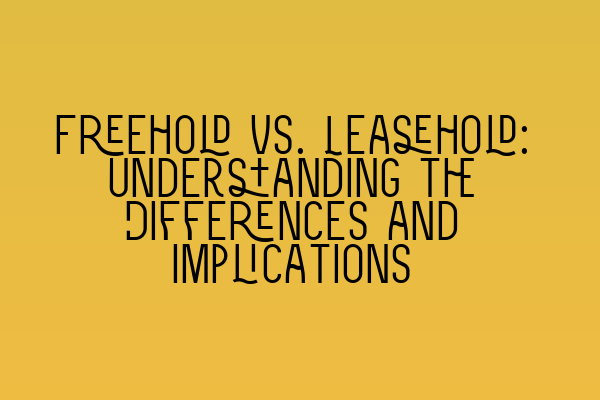Freehold vs. Leasehold: Understanding the Differences and Implications
At SQE Property Law & Land Law, we understand that buying or renting a property is a significant decision that involves various legal considerations. One of the key factors to consider when entering into a property transaction is the distinction between freehold and leasehold.
In this blog post, we will clarify the differences between freehold and leasehold properties, highlight their implications, and guide you through the decision-making process. Whether you are a first-time buyer, a property investor, or a tenant, understanding these concepts is essential for making informed decisions.
So, let’s dive in!
The Basics: Freehold and Leasehold Explained
Freehold properties are those where the buyer acquires absolute ownership of both the property and the land it stands on. In simpler terms, you have complete control and ownership of the property indefinitely. This type of ownership is most commonly associated with houses.
On the other hand, leasehold properties involve a legal agreement between the buyer (known as the leaseholder) and the owner of the land (known as the freeholder or landlord). In a leasehold arrangement, the leaseholder only has exclusive rights to occupy and use the property for a specified period of time. Typically, this period can range from a few decades to several centuries.
Implications of Freehold Ownership
Owning a freehold property comes with several advantages. Firstly, you have the peace of mind that you have complete control over your property. You are not bound by any restrictions imposed by a landlord or management company, giving you the freedom to make changes and alterations to your property as you wish (subject to planning regulations).
Furthermore, freehold ownership gives you the opportunity to benefit from any increase in property value. As a homeowner, you have the potential to build equity in your property and enjoy the financial gains that come with it.
However, it’s important to remember that with freehold ownership also comes responsibility. As a freeholder, you are solely responsible for maintaining and repairing the property, both internally and externally. You will also have to bear the costs associated with these repairs and maintenance.
Understanding Leasehold Ownership
Leasehold ownership is most commonly associated with flats, apartments, and other communal buildings. As a leaseholder, you have the right to occupy and use the property for a specific period of time, as stipulated in the lease agreement.
One of the main considerations when dealing with leasehold properties is the ground rent payable to the freeholder. Ground rent is a fee that leaseholders must pay annually to the freeholder. It is essential to understand the terms and conditions associated with ground rent, as failure to pay it can lead to legal repercussions and even the loss of the leasehold property.
Leaseholders may also be required to pay service charges. These charges contribute to the maintenance and upkeep of communal areas and services, such as shared gardens, corridors, lifts, and security systems. Before purchasing a leasehold property, it is crucial to carefully review the terms of the lease agreement, including any service charge provisions.
Leaseholders also have limited control over the property compared to freeholders. They may need to seek permission from the freeholder or landlord for certain alterations or changes to the property. It is advisable to clarify these restrictions with the freeholder before making any modifications.
The Lease Extension and Enfranchisement Process
For leaseholders, there may come a time when the lease term is running low and they wish to extend it or even acquire the freehold. In such cases, the leaseholder can explore lease extension or enfranchisement options.
Lease extension involves negotiating a new lease term with the freeholder. Leaseholders have legal rights to extend their leases for an additional term, usually for up to 90 years beyond the existing lease. It is crucial to seek legal advice when considering this option, as formal notices and specific procedures must be followed to protect your rights.
Enfranchisement, on the other hand, allows leaseholders to collectively purchase the freehold of their building. This process is available to leaseholders of flats and sometimes houses. By participating in enfranchisement, leaseholders can gain greater control over their property, as they become both leaseholder and freeholder.
Seek Professional Advice for a Smooth Property Transaction
When it comes to property transactions, whether freehold or leasehold, it is crucial to seek professional advice. At SQE Property Law & Land Law, our team of expert solicitors is equipped with the knowledge and experience to guide you through the intricacies of freehold and leasehold ownership.
Whether you are buying a new property, extending a lease, or looking to exercise your enfranchisement rights, we are here to help.
For further information on SQE preparation courses, you can refer to our related articles:
– SQE 1 Practice Exam Questions
– SQE 1 Practice Mocks FLK1 FLK2
– SQE 2 Preparation Courses
– SQE 1 Preparation Courses
– SRA SQE Exam Dates
Contact SQE Property Law & Land Law today to ensure a smooth and successful property transaction. Our team of experts is ready to assist you every step of the way.
